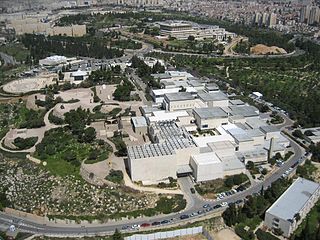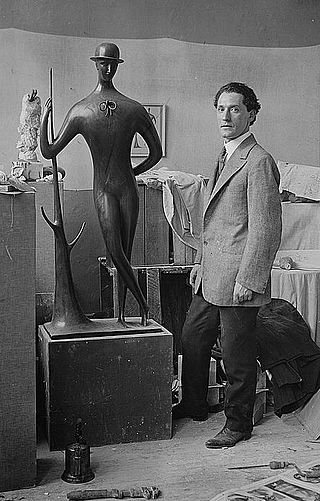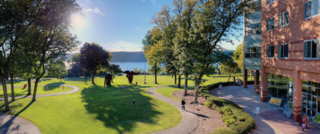
Riverdale is a residential neighborhood in the northwestern portion of the New York City borough of the Bronx. Riverdale, which had a population of 47,850 as of the 2000 United States Census, contains the city's northernmost point at the College of Mount Saint Vincent. Riverdale's boundaries are disputed, but it is commonly agreed to be bordered by Yonkers to the north, Van Cortlandt Park and Broadway to the east, the Kingsbridge neighborhood to the southeast, either the Harlem River or the Spuyten Duyvil neighborhood to the south, and the Hudson River to the west. Riverdale Avenue is the primary north–south thoroughfare through Riverdale.

The Israel Museum is an art and archaeological museum in Jerusalem. It was established in 1965 as Israel's largest and foremost cultural institution, and one of the world's leading encyclopaedic museums. It is situated on a hill in the Givat Ram neighborhood of Jerusalem, adjacent to the Bible Lands Museum, the Knesset, the Israeli Supreme Court, and the Hebrew University of Jerusalem.

Bezalel Academy of Arts and Design is a public college of design and art located in Jerusalem. Established in 1906 by Jewish painter and sculptor Boris Schatz, Bezalel is Israel's oldest institution of higher education and is considered the most prestigious art school in the country. It is named for the Biblical figure Bezalel, son of Uri, who was appointed by Moses to oversee the design and construction of the Tabernacle. The art created by Bezalel's students and professors in the early 1900s is considered the springboard for Israeli visual arts in the 20th century.

Elie Nadelman was a Polish-American sculptor, draughtsman of the School of Paris and a collector of folk art.

Boris Schatz was a Lithuanian Jewish artist and sculptor who settled in Israel. Schatz was the founder of the Bezalel school and would be later known as the father of the Bezalel school movement in Israeli art, that waned in the 1920s following the introduction of modernism in Israel. After Schatz died, part of his art collection, including a famous self portrait by Dutch Master Jozef Israëls, given to him by the artist, eventually became the nucleus of the Israel Museum.

Reuven Rubin was a Romanian-born Israeli painter and Israel's first ambassador to Romania.

The Bezalel school was an art movement in Palestine in the late Ottoman and British Mandate periods. Named for the Bezalel Art School, predecessor of the Bezalel Academy of Art and Design, it has been described as "a fusion of oriental art and Art Nouveau."
Lynda Caspe is a painter, sculptor, and published poet. She was a founding member of the Bowery Gallery in New York City in 1969. She was director of the Bowery Gallery from 2001-2010.

Jewish ceremonial art, also known as Judaica, refers to an array of objects used by Jews for ritual purposes. Because enhancing a mitzvah by performing it with an especially beautiful object is considered a praiseworthy way of honoring God's commandments, Judaism has a long tradition of commissioning ritual objects from craftsmen and artists.

Michael Gitlin is a contemporary sculptor.
Ludwig Yehuda Wolpert, was an Israeli-American goldsmith and designer, born in Germany. He is celebrated as the first artist to design Judaica in modern styles.
Louise Braverman is a New York City-based architect known for a design philosophy that aims to combine aesthetic design and social conscience. She is a Fellow of the American Institute of Architects (FAIA).

Maty Grunberg born 1943, is an Israeli sculptor and known also for his Artist Books.

Michael Sgan-Cohen was an Israeli artist, art historian, curator and critic. His oeuvre touches different realms of the Israeli experience and the Hebrew language, displaying a strong connection to the Jewish Scriptures. His works were nurtured by his extensive knowledge of Art history, philosophy, Biblical Texts, Jewish thought and Mysticism, which in turn illuminated all these pursuits. His engagement with Judaism and the Bible as a secular scholar and his vast knowledge of modern and contemporary art contributed to the development of a distinctive approach which combined Jewish and Israeli symbols and images to create a multilayered and contemporary artistic language.
Israeli ceramics are ceramics designed either in Mandatory Palestine or Israel from the beginning of the 20th century. In additional to traditional pottery, in Israel there are artists whose works were created in an industrial environment. Until the late 1970s there existed in Israel a local tradition that emphasized the local values of nature as an expression of Zionist identity. From the 1980s artistic expressions that sought to undercut this tradition began to appear in the works of Israeli artists, who combined ceramics with other artistic media and with personal, critical agendas.
Svetlana Reingold is an Israeli museologist and curator, who is currently serving as Chief Curator of Haifa Museum of Art.

Dr. Ido Noy is a curator and historian of Jewish art and history, folklore, popular art and ephemera.
The Leningrad Experimental Graphics Laboratory or LEGL was an artists' collective in Soviet Russia that lasted from the time of Khruschev's thaw to the dissolution of the USSR in 1992. Formally, the LEGL was the graphics section of the state-run Artists' Union of the USSR that was based in Leningrad. The group came to the notice of Western critics in 1962, when the London-based collector and art dealer Eric Estorick staged an exhibition of their work at the Grosvenor Gallery. Estorick had purchased over a hundred works by LEGL artists during a trip to the Soviet Union in 1960. A selection of their work was again exhibited in London at the Estorick Gallery in 2019.
Vera Fedorovna Matyukh (1910-2003) was a Russian artist.

RiverSpring Living is an American Health care organization for old adults based in New York. It was founded in 1917 in Harlem as The Hebrew Home and was renamed RiverSpring Living in 2021.














